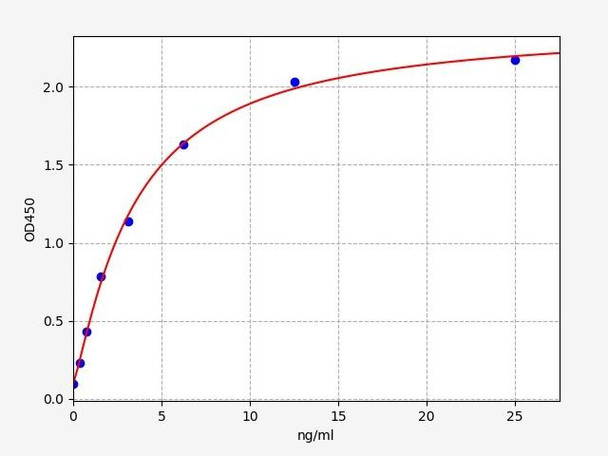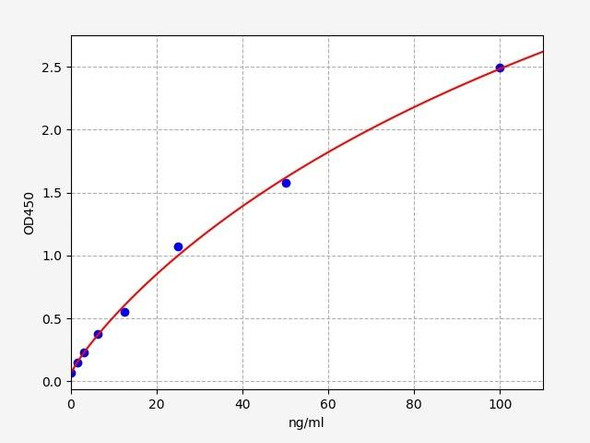Mouse GAD1 / Glutamate decarboxylase 1 ELISA Kit
- SKU:
- MOFI00379
- Product Type:
- ELISA Kit
- Size:
- 96 Assays
- Uniprot:
- P48318
- Sensitivity:
- 0.234ng/ml
- Range:
- 0.391-25ng/ml
- ELISA Type:
- Sandwich
- Synonyms:
- Gad1, GAD1, Glutamate Decarboxylase 1, GAD67, GAD25, Glutamate decarboxylase 67 kDa isoform
- Reactivity:
- Mouse
- Research Area:
- Neuroscience
Description
Mouse GAD1/Glutamate decarboxylase 1 ELISA Kit
The Mouse GAD1 (Glutamate Decarboxylase 1) ELISA Kit is a highly sensitive and specific assay designed for the accurate detection of GAD1 levels in mouse serum, plasma, and cell culture supernatants. This kit provides reliable and reproducible results, making it ideal for a variety of research applications.GAD1 is an important enzyme involved in the production of the neurotransmitter gamma-aminobutyric acid (GABA) in the brain. Dysregulation of GAD1 has been implicated in various neurological disorders, including epilepsy, schizophrenia, and Parkinson's disease.
Therefore, measuring GAD1 levels can provide valuable insights into the pathophysiology of these conditions and aid in the development of potential therapeutics. With its high sensitivity and specificity, the Mouse GAD1 ELISA Kit is a valuable tool for researchers studying the role of GAD1 in neurobiology and exploring its potential as a therapeutic target.
| Product Name: | Mouse GAD1 / Glutamate decarboxylase 1 ELISA Kit |
| Product Code: | MOFI00379 |
| Size: | 96 Assays |
| Alias: | Gad1, GAD1, Glutamate Decarboxylase 1, GAD67, GAD25, Glutamate decarboxylase 67 kDa isoform |
| Detection Method: | Sandwich ELISA |
| Application: | This immunoassay kit allows for the in vitro quantitative determination of Mouse Gad1 concentrations in serum plasma and other biological fluids. |
| Sensitivity: | 0.234ng/ml |
| Range: | 0.391-25ng/ml |
| Storage: | 4°C for 6 months |
| Note: | For Research Use Only |
| Recovery: | Matrices listed below were spiked with certain level of Mouse Gad1 and the recovery rates were calculated by comparing the measured value to the expected amount of Mouse Gad1 in samples. | ||||||||||||||||
| |||||||||||||||||
| Linearity: | The linearity of the kit was assayed by testing samples spiked with appropriate concentration of Mouse Gad1 and their serial dilutions. The results were demonstrated by the percentage of calculated concentration to the expected. | ||||||||||||||||
| |||||||||||||||||
| Intra Assay: | CV <8% | ||||||||||||||||
| Inter Assay: | CV <10% |
| Component | Quantity | Storage |
| ELISA Microplate (Dismountable) | 8-12 strips | 4°C for 6 months |
| Lyophilized Standard | 2 | 4°C/-20°C |
| Sample/Standard Dilution Buffer | 20ml | 4°C |
| Biotin-labeled Antibody(Concentrated) | 120ul | 4°C (Protect from light) |
| Antibody Dilution Buffer | 10ml | 4°C |
| HRP-Streptavidin Conjugate(SABC) | 120ul | 4°C (Protect from light) |
| SABC Dilution Buffer | 10ml | 4°C |
| TMB Substrate | 10ml | 4°C (Protect from light) |
| Stop Solution | 10ml | 4°C |
| Wash Buffer(25X) | 30ml | 4°C |
| Plate Sealer | 5 | - |
Other materials and equipment required:
- Microplate reader with 450 nm wavelength filter
- Multichannel Pipette, Pipette, microcentrifuge tubes and disposable pipette tips
- Incubator
- Deionized or distilled water
- Absorbent paper
- Buffer resevoir
| Uniprot | P48318 |
| UniProt Protein Function: | GAD67: Catalyzes the production of GABA. Homodimer. Isoform 3 is expressed in pancreatic islets, testis, adrenal cortex, and perhaps other endocrine tissues, but not in brain. Belongs to the group II decarboxylase family. 3 isoforms of the human protein are produced by alternative splicing. |
| UniProt Protein Details: | Protein type:Other Amino Acids Metabolism - taurine and hypotaurine; Amino Acid Metabolism - alanine, aspartate and glutamate; Mitochondrial; EC 4.1.1.15; Carbohydrate Metabolism - butanoate; Other Amino Acids Metabolism - beta-alanine; Lyase Cellular Component: mitochondrion; axon; cytoplasm; presynaptic active zone; synapse; cell cortex; intracellular; nerve terminal Molecular Function:glutamate binding; glutamate decarboxylase activity; protein heterodimerization activity; lyase activity; carboxy-lyase activity; protein N-terminus binding; catalytic activity; pyridoxal phosphate binding Biological Process: gamma-aminobutyric acid biosynthetic process; carboxylic acid metabolic process; social behavior; neurotransmitter biosynthetic process |
| NCBI Summary: | The protein encoded by this gene is an enzyme that catalyzes the production of gamma-aminobutyric acid from L-glutamic acid. Alternative splicing of this gene results in two products, the predominant 67 kDa isoform and a smaller 25 kDa isoform. The smaller isoform is not thought to retain catalytic activity. [provided by RefSeq, Aug 2015] |
| UniProt Code: | P48318 |
| NCBI GenInfo Identifier: | 31982847 |
| NCBI Gene ID: | 14415 |
| NCBI Accession: | NP_032103.2 |
| UniProt Secondary Accession: | P48318,O08685, |
| UniProt Related Accession: | P48318 |
| Molecular Weight: | 66,648 Da |
| NCBI Full Name: | glutamate decarboxylase 1 |
| NCBI Synonym Full Names: | glutamate decarboxylase 1 |
| NCBI Official Symbol: | Gad1 |
| NCBI Official Synonym Symbols: | EP10; GAD25; GAD44; GAD67; Gad-1 |
| NCBI Protein Information: | glutamate decarboxylase 1; GAD-67; glutamic acid decarboxylase 1; 67 kDa glutamic acid decarboxylase; glutamate decarboxylase 67 kDa isoform; GLUTAMATE DECARBOXYLASE, 67 KD ISOFORM (GAD-67) (67 KD GLUTAMIC ACID DECARBOXYLASE) |
| UniProt Protein Name: | Glutamate decarboxylase 1 |
| UniProt Synonym Protein Names: | 67 kDa glutamic acid decarboxylase; GAD-67; Glutamate decarboxylase 67 kDa isoform |
| Protein Family: | Glutamate decarboxylase |
| UniProt Gene Name: | Gad1 |
| UniProt Entry Name: | DCE1_MOUSE |
*Note: Protocols are specific to each batch/lot. For the correct instructions please follow the protocol included in your kit.
| Step | Procedure |
| 1. | Set standard, test sample and control (zero) wells on the pre-coated plate respectively, and then, record their positions. It is recommended to measure each standard and sample in duplicate. Wash plate 2 times before adding standard, sample and control (zero) wells! |
| 2. | Aliquot 0.1ml standard solutions into the standard wells. |
| 3. | Add 0.1 ml of Sample / Standard dilution buffer into the control (zero) well. |
| 4. | Add 0.1 ml of properly diluted sample (Human serum, plasma, tissue homogenates and other biological fluids.) into test sample wells. |
| 5. | Seal the plate with a cover and incubate at 37 °C for 90 min. |
| 6. | Remove the cover and discard the plate content, clap the plate on the absorbent filter papers or other absorbent material. Do NOT let the wells completely dry at any time. Wash plate X2. |
| 7. | Add 0.1 ml of Biotin- detection antibody working solution into the above wells (standard, test sample & zero wells). Add the solution at the bottom of each well without touching the side wall. |
| 8. | Seal the plate with a cover and incubate at 37°C for 60 min. |
| 9. | Remove the cover, and wash plate 3 times with Wash buffer. Let wash buffer rest in wells for 1 min between each wash. |
| 10. | Add 0.1 ml of SABC working solution into each well, cover the plate and incubate at 37°C for 30 min. |
| 11. | Remove the cover and wash plate 5 times with Wash buffer, and each time let the wash buffer stay in the wells for 1-2 min. |
| 12. | Add 90 µL of TMB substrate into each well, cover the plate and incubate at 37°C in dark within 10-20 min. (Note: This incubation time is for reference use only, the optimal time should be determined by end user.) And the shades of blue can be seen in the first 3-4 wells (with most concentrated standard solutions), the other wells show no obvious color. |
| 13. | Add 50 µL of Stop solution into each well and mix thoroughly. The color changes into yellow immediately. |
| 14. | Read the O.D. absorbance at 450 nm in a microplate reader immediately after adding the stop solution. |
When carrying out an ELISA assay it is important to prepare your samples in order to achieve the best possible results. Below we have a list of procedures for the preparation of samples for different sample types.
| Sample Type | Protocol |
| Serum: | If using serum separator tubes, allow samples to clot for 30 minutes at room temperature. Centrifuge for 10 minutes at 1,000x g. Collect the serum fraction and assay promptly or aliquot and store the samples at -80°C. Avoid multiple freeze-thaw cycles. If serum separator tubes are not being used, allow samples to clot overnight at 2-8°C. Centrifuge for 10 minutes at 1,000x g. Remove serum and assay promptly or aliquot and store the samples at -80°C. Avoid multiple freeze-thaw cycles. |
| Plasma: | Collect plasma using EDTA or heparin as an anticoagulant. Centrifuge samples at 4°C for 15 mins at 1000 - g within 30 mins of collection. Collect the plasma fraction and assay promptly or aliquot and store the samples at -80°C. Avoid multiple freeze-thaw cycles. Note: Over haemolysed samples are not suitable for use with this kit. |
| Urine & Cerebrospinal Fluid: | Collect the urine (mid-stream) in a sterile container, centrifuge for 20 mins at 2000-3000 rpm. Remove supernatant and assay immediately. If any precipitation is detected, repeat the centrifugation step. A similar protocol can be used for cerebrospinal fluid. |
| Cell culture supernatant: | Collect the cell culture media by pipette, followed by centrifugation at 4°C for 20 mins at 1500 rpm. Collect the clear supernatant and assay immediately. |
| Cell lysates: | Solubilize cells in lysis buffer and allow to sit on ice for 30 minutes. Centrifuge tubes at 14,000 x g for 5 minutes to remove insoluble material. Aliquot the supernatant into a new tube and discard the remaining whole cell extract. Quantify total protein concentration using a total protein assay. Assay immediately or aliquot and store at ≤ -20°C. |
| Tissue homogenates: | The preparation of tissue homogenates will vary depending upon tissue type. Rinse tissue with 1X PBS to remove excess blood & homogenize in 20ml of 1X PBS (including protease inhibitors) and store overnight at ≤ -20°C. Two freeze-thaw cycles are required to break the cell membranes. To further disrupt the cell membranes you can sonicate the samples. Centrifuge homogenates for 5 mins at 5000xg. Remove the supernatant and assay immediately or aliquot and store at -20°C or -80°C. |
| Tissue lysates: | Rinse tissue with PBS, cut into 1-2 mm pieces, and homogenize with a tissue homogenizer in PBS. Add an equal volume of RIPA buffer containing protease inhibitors and lyse tissues at room temperature for 30 minutes with gentle agitation. Centrifuge to remove debris. Quantify total protein concentration using a total protein assay. Assay immediately or aliquot and store at ≤ -20 °C. |
| Breast Milk: | Collect milk samples and centrifuge at 10,000 x g for 60 min at 4°C. Aliquot the supernatant and assay. For long term use, store samples at -80°C. Minimize freeze/thaw cycles. |










